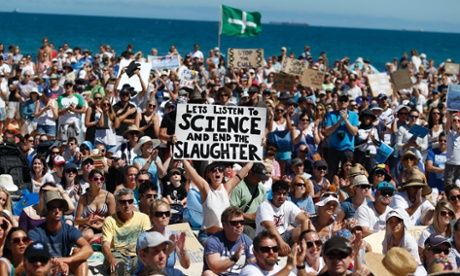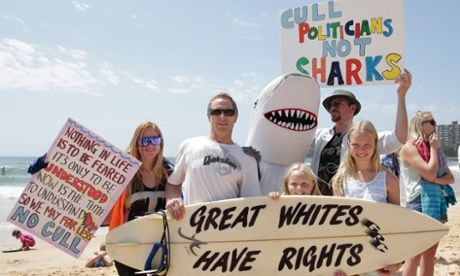
Playing up the ancient fear of monsters of the deep, Barnett responded to a series of fatal shark attacks last year by setting up drums trailing chains with baited hooks to catch, shoot and dump sharks of more than three metres length out at sea. The federal minister for the environment Greg Hunt gave Barnett a special exemption to ignore the national protected status of the great white shark.
The great white is the monster of the deep. It is found in all the earth's oceans, lives for 30 years or more, grows to six metres in length and more than two tonnes in weight, and feeds primarily on fish. It has no more trouble cruising from Australia to South Africa and back than it does returning year after year to its favoured seal colony when the seal pups are leaving the land to begin feeding in the sea - this has proven a dangerous place to be for people in wetsuits.
Many more Australians die in road smashes each year (more than 1,000), and from drowning (more than 100) than from shark attacks and in both cases, Western Australia has the nation's biggest per capita toll. Worldwide, fewer than 100 humans are eaten by sharks each year though mosquitos kill millions, and it is estimated that we kill and eat up to 100m sharks of all species each year.
Like the other monsters of life on earth, the great white shark is a pale threat when compared with the planet's most colourful killer, modern Homo sapiens. Our herd of more than seven billion omnivorous mammals is marauding the biosphere. We are destroying all competing predators from tigers to polar bears and the great sharks. Sharks have swum Earth's seas for 400m years. They have seen the dinosaurs come and go. But now, due to the human impact on their domain, species like the great white are threatened and listed as vulnerable.
There has been a popular backlash against Barnett's cull. Thousands of people have turned out for protests on beaches around Australia, including 6,000 at Perth's Cottesloe Beach where baited drums now float offshore.
The lone Perth daily, the Western Australian, has been in lockstep with its conservative premier. However, the media elsewhere has reflected the public feeling. The Hobart Mercury ran an editorial headed "Shark cull indefensible", quoting Tasmanian expert Chris Black:
The ocean isn't a hotel swimming pool, it's a wild place ... we don't have an unassailable right to feel safe in the ocean, we can't just exterminate every animal that we see as being dangerous.That is the growing Australian sentiment.
There was a watershed in 1985 with the sensational survival of Val Plumwood, a lone woman in the Northern Territory, after she was ambushed by another terrifying stalker of the wilds, a saltwater crocodile. Plumwood, a philospher, went canoeing to look for Aboriginal rock art. The large reptile attacked her canoe and dragged her through three death rolls under water. Almost unconscious, she made an astonishing escape and, with gaping leg wounds, was rescued by a late-night search party.
Recovering in hospital, Plumwood stoked world headlines by calling for the hunt to kill the crocodile which attacked her to be stopped. She later commented:
The outrage we experience at the idea of being eaten is certainly not what we experience at the idea of animals as food. We may daily consume other animals by the billions, but we ourselves cannot be food for worms and certainly not meat for crocodiles.Plumwood's plea for her predator echoes through the debate triggered by Barnett and his shark hook. A number of the families of shark victims have spoken out against the cull of the great whites, as have scientists and fishermen.
In a similar vein, in his book White Pointer South Chris Black describes the six-metres long, female monster caught in the net of Tasmanian fisherman Robert Cunningham and his brother at Tasmania's Pirates Bay in 1993. It carted the net six kilometres along the coast before dying. Black writes:
White sharks, particularly individuals as large and as potent as the 1993 specimen, are an important environmental factor in the regulation of the fur seal population. As such, their presence in the wild benefits fishermen, who often find themselves in conflict with seals that opportunistically compete for the catches in their nets ... the removal of even a single sexually mature female white shark from the breeding stock is likely to have potentially serious ramifications for a species of such comparatively low fecundity. Unlike other shark species ... Carcharodon typically bears litters of less than 10 pups, perhaps as infrequently as every three years.Queensland has killed hundreds of sharks with baited hooks and nets since 1962, while New South Wales nets snare even more. More nets or drums with baited hooks are being set at other great white sharks strongholds neat the Reunion Island in the Indian Ocean, and in South Africa. The outcome is inevitable: the great white, now down to an estimated 3,500 individuals, will move from being "vulnerable to extinction" to "endangered with extinction", to extinct. Barnett's way is for jellyfish to rule. The hope lies in that public revolt.
Cunningham caught another great white in his net in 1999. He took risks to cut it free, and it is most probably still alive in the deeps. He told Black:
As far as big sharks go, for sure ... if it's possible to free them, let them go. You always do. They're just not worth the hassle, plus I'd rather see them swim. I surf, dive, and swim, and the way I look at it, you take your chances in their world.




Look, sharks are one of two things Im actually afraid of but something must be said. We are catching all the primary food sources of these animals. Many animals washed up are either choked with plastics, or starved from lack of fish in the ocean from our fishing industries. When your primary food source dries up you go for that lovely sweet smelling pink buffet thats swimming right for me. We werent food before, sharks would take a nip and go away after they realise our blood isnt seal blood. That no longer matters, food is food and anyone going into the water is on the menu. Consequence of our actions. So now we cull the sharks? I have a better idea which species gets culled.